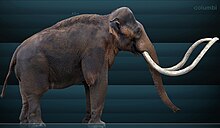Paleontology in Nebraska
Paleontology in Nebraska refers to
Prehistory

No Precambrian fossils are known from Nebraska, and the state's fossil record begins in the Paleozoic. From the Cambrian through the Devonian, Nebraska was covered by a shallow sea. None of the rocks deposited in this environment are exposed at the surface, so its fossil record is poorly known. Nevertheless, the fossil record of nearby states suggests that Nebraska was probably home to brachiopods, corals, and trilobites.[2] During the Carboniferous, the sea retreated westward and was replaced by large swamps growing in river deltas.[2] During the Carboniferous Period, local invertebrates included cephalopods, coral, crinoids and fusulinids. On land, the local flora also left behind fossils.[1]: 192 During the Permian, most of Nebraska was a terrestrial environment, but both brackish and freshwater habitats were present. The latter were home to aquatic plants, amphibians, and fishes.[2]
From the
The Western Interior Seaway was gone from Nebraska by the early portion of the
Rhinoceroses remained and were a prominent member of
During the
During the middle
During the ensuing
Post-
History
Indigenous interpretations

Local indigenous people devised legends to explain the fossils they encountered. The
The fossils of the Niobrara chalk may have been influential on these stories. The
The Cheyenne believe that there were many different kinds of water monsters that lived not only in lakes, rivers, and springs but also high bluffs and hills. The locations given as water monster habitat are similar to the locations where local marine fossils can be found as fossils often erode out of hillsides or stream banks. The Cheyennes feared the water monsters, because they could be dangerous predators or capsize their canoes. Even in modern times, tradition-minded Cheyenne sometimes take pains to avoid sleeping to close to springs due to fears of water monsters.[7]: 211
Scientific research

The
Only a few miles away from the Agate Springs deposits,
In 1961, the University of Nebraska opened the Trailside Museum of Natural History at
Protected areas
Natural history museums
- Hastings Museum of Natural and Cultural History, Hastings, Nebraska
- Trailside Museum of Natural History at Fort Robinson State Park, Crawford, Nebraska
- University of Nebraska State Museum, Lincoln, Nebraska
Footnotes
- ^ a b c d e f g h i j k l m n o p q r s t u v w x y Murray (1974); "Nebraska".
- ^ a b c d e f g h Springer (2005); "Paleontology and geology".
- ^ Witzke (2001); page 4.
- ^ Everhart (2005); "One Day in the Life of a Mosasaur", page 5.
- ^ Everhart (2005); "Other Times, Other Sharks", page 69.
- ^ Lockley and Hunt (1999); "The Puzzle of Miocene Tracks in the Oligocene", page 260.
- ^ a b c Mayor (2005); "Cheyenne Fossil Knowledge".
- ^ Lockley and Hunt (1999); "The Age of Birds and Mammals: The Cenozoic Era", page 243.
References
- Everhart, M. J. 2005. Oceans of Kansas - A Natural History of the Western Interior Sea. Indiana University Press, 320 pp.
- Lockley, Martin and Hunt, Adrian. Dinosaur Tracks of Western North America. Columbia University Press. 1999.
- Mayor, Adrienne. Fossil Legends of the First Americans. Princeton University Press. 2005. ISBN 0-691-11345-9.
- Murray, Marian (1974). Hunting for Fossils: A Guide to Finding and Collecting Fossils in All 50 States. Collier Books. p. 348. ISBN 9780020935506.
- Springer, Dale. July 6, 2005. "Nebraska, US." The Paleontology Portal. Accessed September 21, 2012.
- Witzke, Brian J. The Age of Dinosaurs in Iowa. Iowa Geology. Number 26. 2001. Pages 2–7.
